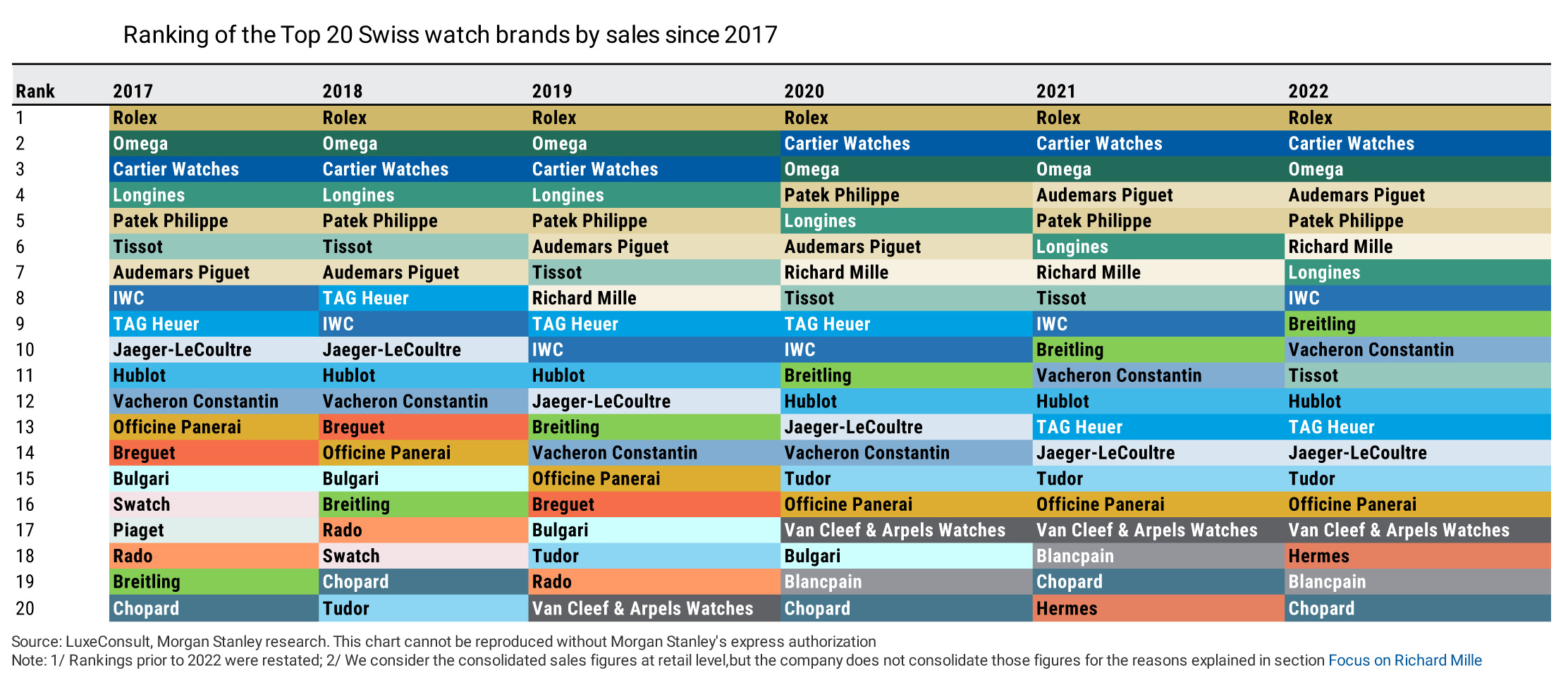Today’s release of the eagerly anticipated Morgan Stanley and Luxconsult report on the state of the Swiss watch market is full of fascinating insights.
As the report’s authors note, it is another year of the strongest brands consolidating their power, with Rolex stretching its lead over all others after a year of sales estimated (never confirmed) of CHF 9.3 billion.
Its stablemate Tudor is surging as well. The brand was outside the top 20 in 2017, but is now ranked above Panerai and Blancpain at number 15 in the league table.
It occurred to me, looking at the rise and fall of brands in the league over the past six years how influential monobrand boutiques have become.

The marques that have been rolling them out fastest over this period, Audemars Piguet, Rolex, Breitling, Omega, TAG Heuer and Tudor have been outperforming their direct rivals, particularly in Western markets.
Swatch Group historically concentrated its roll out of boutiques in China, which has been the worst affected by the pandemic, and brands like Tissot and Longines have been losing ground in part because they are not getting the same investment at retail as their competitors.
It is a complicated picture. Monobrand retail come in many forms. Some brands like Audemars Piguet mainly run their own “internal” boutiques. Most work with retail partners like Bucherer, Watches of Switzerland, Hour Glass and others, on a franchise model.
Brands appear to prefer their watches to be sold in these immersive environments, and rig the system by hoarding boutique-only special watches for them, which naturally makes them more successful.
I hope retailers find a way to keep the benefits of multibrand stores, where watches from many manufacturers can be judged side-by-side, but I fear this battle is being lost, as we see in the relative performance of the brands in Morgan Stanley’s estimates.
Less is more
A related trend identified in the report is the way brands are cutting points of sale across the world.
As we reported earlier this month, Patek Philippe is reducing its number of worldwide doors by 30%.
Rolex has been pruning its network more slowly, but the result is the same.
Since 2014, the number of Rolex doors in the United States has dropped from 468 to 301; about a third lower.
In the UK, the network has been trimmed from 130 to 97 doors over the same nine year period.
Remaining points of sale are usually larger, in better locations, and often fully branded environments.
Brands constantly tell me they want to get closer to their customers without losing the benefit of working with retail partners who are expert in their towns and cities.
In reality, with the exception of Rolex, they are doing less wholesale and more direct to consumer sales.
Richard Mille is 100% direct, and has become the sixth biggest brand in the world despite selling a mere 5,300 watches last year.
Richemont brands are doing less wholesale. In the case of Vacheron Constantin, under half its watches go into distribution, 55% is direct.
Breitling is a brand to watch. It is rolling out boutiques with retail partners, but is squeezing its partners at the same time. Morgan Stanley thinks 40% of its sales are DTC.
The conclusion is that we are heading towards a world with fewer brands commanding more space. Is that a better world? We will see.


Fewer brands commanding more space = reduced competition. The prevailing perception is that this in not in the best interests of the consumer. Time will tell…
The relationship between ‘Unit Average Sale’, Market Position and the inverse relationship of limiting points of sale as one climbs the ladder successfully driven Price and Perception. Richard Mille, by definition, is taking 100% of the Profit over Manufacture and Marketing as they go direct to the Consumer, which the economies of scale allow. Rolex, Patel, AP sit alone on top of Brand awareness, Quality, Image and retained Value. It took Rolex 15 years after the Tudor re-launch to figure out, sales with-in Rolex announced stores of Tudor were ‘instead of sales’ and economically driven as the little brother or sister brand. Once awakened, and a fresh strategy applied, if they can grow parallel in the Retail Marketplace, in the non-Rolex store, they are important and erode the dominance of brands like TAG-Heuer, Breitling, Omega, a Heritage, Value and Price competition are present. The big issue, is why did it take Rolex so long to see this, given their market position and philosophy. The 2nd tier Volume Luxe category, is also influenced by Momo-look niche Brands, which thrived in the early millennia, like Panarai, Hublot, Ulysses-Nardin, and then the following tiers of B&R, Bremont, Alaina’s etc.. Distribution channels are still fluid and will remain same as we enter the next chapter of Retail, where Volume has a common denominator of Unit Value in Market Position.
Wonderful chart, and it especially nice that it goes back to 2017 for better understanding.
A few thoughts that jump out at me, if the above is accurate:
-Would be nice to see the turnover/volume numbers for each manufacture. Sure, 7-10 place is nice, but not if it represents only peanuts of the top 5.
-The declination of JLC is staggering, and you have to wonder if its due to their boutique objective versus wholesale/retailer reach. One has to wonder how many people are going out of there way to make a trip to a primary city to purchase from their boutiques. Time will tell if that strategy is a mistake.
-Is anyone at the wheel driving Longines and Breguet? Swatch Group tends to only be able to focus on one brand at a time in its portfolio. That one brand has been Omega lately, at the sacrifice of the rest.
-Hublot outperforming or on par with Tag Heuer speaks volumes about Tag Heuer’s direction.
-Finally, Bulgari in relation to Chopard and VCA. Disappointing results given their recent efforts and marketing push. Very strange.
Which the above brings me back to the original point. Are the top 5/6 swallowing all the market share? with Rolex and Cartier and Omega production numbers, it appears they are not only in turnover dollars, but quite possibly in volume as well. Social media sure makes it feel that way.
“It occurred to me, looking at the rise and fall of brands in the league over the past six years how influential monobrand boutiques have become.”
I often wondered why all brands don’t have their own showrooms dedicated to their brand in major markets, AND have on display ALL of their models for customers to try on the wrist. Of course the brand can’t have every model in inventory at every location, but the watch could be sold and delivered direct to the customer.
In the case of Rolex Boutiques, do I go into the shop expecting to see and try on all Rolex models only to find the showcases completely empty? When I visited the Rolex only boutique in London, I was so disappointed. Rolex doesn’t need a separate boutique, UNLESS they have every model for a customer to try on, which its AD’s do not do in their multi-brand stores.